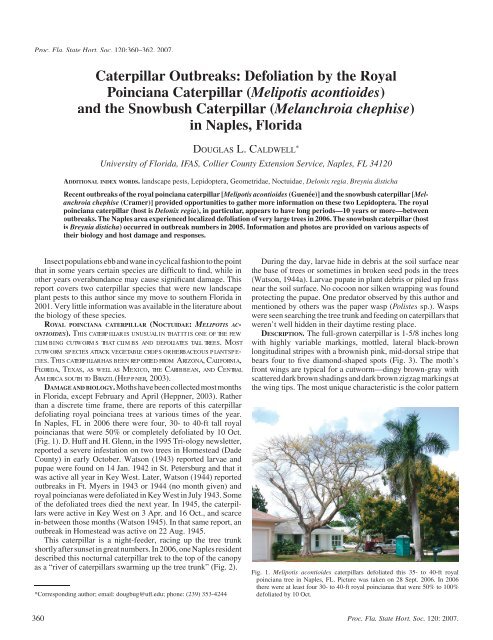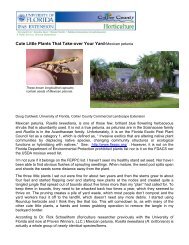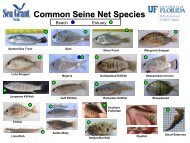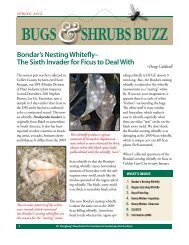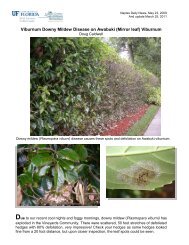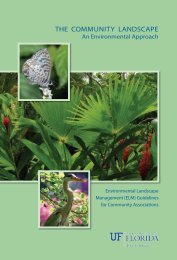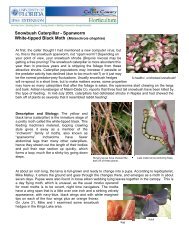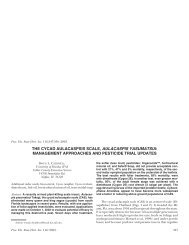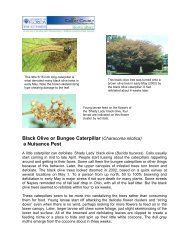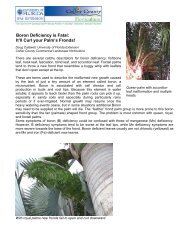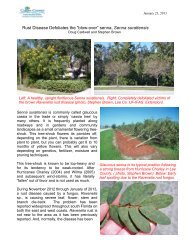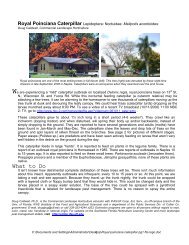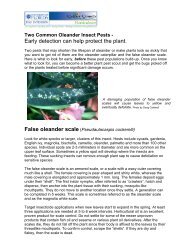Defoliation By The Royal Poinciana - Collier County Extension ...
Defoliation By The Royal Poinciana - Collier County Extension ...
Defoliation By The Royal Poinciana - Collier County Extension ...
Create successful ePaper yourself
Turn your PDF publications into a flip-book with our unique Google optimized e-Paper software.
Proc. Fla. State Hort. Soc. 120:360–362. 2007.<br />
Caterpillar Outbreaks: <strong>Defoliation</strong> by the <strong>Royal</strong><br />
<strong>Poinciana</strong> Caterpillar (Melipotis ( acontioides acontioides)<br />
and the Snowbush Caterpillar (Melanchroia ( chephise chephise)<br />
in Naples, Florida<br />
*Corresponding author; email: dougbug@ufl .edu; phone: (239) 353-4244<br />
DOUGLAS L. CALDWELL *<br />
University of Florida, IFAS, <strong>Collier</strong> <strong>County</strong> <strong>Extension</strong> Service, Naples, FL 34120<br />
ADDITIONAL INDEX WORDS. landscape pests, Lepidoptera, Geometridae, Noctuidae, Delonix regia, Breynia disticha<br />
Recent outbreaks of the royal poinciana caterpillar [Melipotis acontioides (Guenée)] and the snowbush caterpillar [Melanchroia<br />
chephise (Cramer)] provided opportunities to gather more information on these two Lepidoptera. <strong>The</strong> royal<br />
poinciana caterpillar (host is Delonix regia), in particular, appears to have long periods—10 years or more—between<br />
outbreaks. <strong>The</strong> Naples area experienced localized defoliation of very large trees in 2006. <strong>The</strong> snowbush caterpillar (host<br />
is Breynia disticha) occurred in outbreak numbers in 2005. Information and photos are provided on various aspects of<br />
their biology and host damage and responses.<br />
Insect populations ebb and wane in cyclical fashion to the point<br />
that in some years certain species are diffi cult to fi nd, while in<br />
other years overabundance may cause signifi cant damage. This<br />
report covers two caterpillar species that were new landscape<br />
plant pests to this author since my move to southern Florida in<br />
2001. Very little information was available in the literature about<br />
the biology of these species.<br />
ROYAL POINCIANA CATERPILLAR (NOCTUIDAE: MELIPOTIS AC-<br />
ONTIOIDES). THIS CATERP ILLAR IS UNUSUAL IN THAT IT IS ONE OF THE FEW<br />
CLIM BING CUTWORM S THAT CLIM BS AND DEFOLIATES TALL TREES. MOST<br />
CUTWORM SP ECIES ATTACK VEGETABLE CROP S OR HERBACEOUS P LANT SP E-<br />
CIES. THIS CATERP ILLAR HAS BEEN REP ORTED FROM ARIZONA, CALIFORNIA,<br />
FLORIDA, TEXAS, AS WELL AS MEXICO, THE CARIBBEAN, AND CENTRAL<br />
AM ERICA SOUTH TO BRAZIL (HEP P NER, 2003).<br />
DAMAGE AND BIOLOGY.Moths have been collected most months<br />
in Florida, except February and April (Heppner, 2003). Rather<br />
than a discrete time frame, there are reports of this caterpillar<br />
defoliating royal poinciana trees at various times of the year.<br />
In Naples, FL in 2006 there were four, 30- to 40-ft tall royal<br />
poincianas that were 50% or completely defoliated by 10 Oct.<br />
(Fig. 1). D. Huff and H. Glenn, in the 1995 Tri-ology newsletter,<br />
reported a severe infestation on two trees in Homestead (Dade<br />
<strong>County</strong>) in early October. Watson (1943) reported larvae and<br />
pupae were found on 14 Jan. 1942 in St. Petersburg and that it<br />
was active all year in Key West. Later, Watson (1944) reported<br />
outbreaks in Ft. Myers in 1943 or 1944 (no month given) and<br />
royal poincianas were defoliated in Key West in July 1943. Some<br />
of the defoliated trees died the next year. In 1945, the caterpillars<br />
were active in Key West on 3 Apr. and 16 Oct., and scarce<br />
in-between those months (Watson 1945). In that same report, an<br />
outbreak in Homestead was active on 22 Aug. 1945.<br />
This caterpillar is a night-feeder, racing up the tree trunk<br />
shortly after sunset in great numbers. In 2006, one Naples resident<br />
described this nocturnal caterpillar trek to the top of the canopy<br />
as a “river of caterpillars swarming up the tree trunk” (Fig. 2).<br />
During the day, larvae hide in debris at the soil surface near<br />
the base of trees or sometimes in broken seed pods in the trees<br />
(Watson, 1944a). Larvae pupate in plant debris or piled up frass<br />
near the soil surface. No cocoon nor silken wrapping was found<br />
protecting the pupae. One predator observed by this author and<br />
mentioned by others was the paper wasp (Polistes sp.). Wasps<br />
were seen searching the tree trunk and feeding on caterpillars that<br />
weren’t well hidden in their daytime resting place.<br />
DESCRIPTION. <strong>The</strong> full-grown caterpillar is 1-5/8 inches long<br />
with highly variable markings, mottled, lateral black-brown<br />
longitudinal stripes with a brownish pink, mid-dorsal stripe that<br />
bears four to fi ve diamond-shaped spots (Fig. 3). <strong>The</strong> moth’s<br />
front wings are typical for a cutworm—dingy brown-gray with<br />
scattered dark brown shadings and dark brown zigzag markings at<br />
the wing tips. <strong>The</strong> most unique characteristic is the color pattern<br />
Fig. 1. Melipotis acontioides caterpillars defoliated this 35- to 40-ft royal<br />
poinciana tree in Naples, FL. Picture was taken on 28 Sept. 2006. In 2006<br />
there were at least four 30- to 40-ft royal poincianas that were 50% to 100%<br />
defoliated by 10 Oct.<br />
360 Proc. Fla. State Hort. Soc. 120: 2007.
Fig. 2. <strong>The</strong> “river of caterpillars” streams up a royal poinciana trunk. Melipotis<br />
acontioides is a night-feeder and races up the tree trunk shortly after sunset in<br />
great numbers as if a dinner bell had sounded.<br />
Fig. 3. <strong>The</strong> full-grown royal poinciana caterpillar is about 1-5/8 inches long.<br />
(Photo by Lyle Buss, University of Florida)<br />
of the hind wings. Each hind wing is mostly white with a brown<br />
blotch toward the edge. <strong>The</strong> wingspread is about 1-1/2 inches.<br />
COMMON HOSTS. Common hosts are Leguminosae: Caesalpinioideae,<br />
such as royal poinciana (Delonix regia), Poeppigia<br />
procera, and Parkinsonia species, including Jerusalem thorn<br />
(P. aculeata). This caterpillar has been released as a biocontrol<br />
agent for management of Jerusalem thorn in northern Australia<br />
where the plant has become an invasive weed species. This author<br />
attempted a crude feeding selectivity test with fi ve larvae<br />
in ZipLoc® bags with the foliage of just one legume species:<br />
wild tamarind [Lysiloma sp. (probably latisiliqua)], sweet acacia<br />
(Acacia ( farnesiana<br />
), and popcorn cassia (Senna didymobotrya).<br />
<strong>The</strong>re was very little to no feeding on these plant species in this<br />
simple test. Another variable to be considered is that the foliage of<br />
some legumes becomes toxic after it is picked (Dr. David Wagner,<br />
University of Connecticut, personal communication).<br />
Should one have an outbreak of this caterpillar, there would<br />
be no need to spray an insecticide into the upper canopy due to<br />
a weak link in the caterpillar’s behavior—the nightly ascending<br />
Proc. Fla. State Hort. Soc. 120: 2007.<br />
Fig. 4. Snowbush caterpillars start feeding at the top of the shrubs and work their<br />
way down—even stripping the bark off when the foliage is gone.<br />
and descending of the tree. Contact insecticides could be applied<br />
just to the base of the tree. A burlap or cloth banding trap could<br />
be wrapped around the trunk. <strong>The</strong> hiding caterpillars could easily<br />
be removed by changing the band on a regular basis.<br />
<strong>The</strong> mystery remains as to why there are such long periods<br />
between outbreaks and why the damage has occurred in different<br />
months and on select trees. Certain trees seem to be targeted<br />
and defoliated while nearby trees have very little or no feeding<br />
(Watson, 1944; and personal observation, 2006). <strong>Royal</strong> poinciana<br />
is native to Madagascar and the moth is not known in that<br />
country. Why the caterpillar does so well on this foreign tree is<br />
also intriguing. More information is needed on alternative hosts,<br />
where the caterpillars are spending most of the year, predators<br />
and parasites, and the number of eggs each female produces and<br />
where they are deposited.<br />
SNOWBUSH CATERPILLAR (GEOMETRIDAE: MELANCHROIA CHE-<br />
PHISE). This moth is reported throughout Florida, Texas, and south<br />
to Paraguay. Caterpillars must be active year-round as moths have<br />
been collected year-round in Florida (Heppner, 2003).<br />
DAMAGE AND BIOLOGY. This inchworm (sometimes referred<br />
to as spanworm) occurred in outbreak numbers in mid-July<br />
2005. Caterpillars had defoliated many 3- to 5-ft-tall hedges of<br />
snowbush (Breynia disticha) in <strong>Collier</strong> <strong>County</strong>. Damage appears<br />
on new foliage and the caterpillars work downward (Fig. 4).<br />
In some areas, due to repeating generations of caterpillars, the<br />
hedges had been denuded and the caterpillars were chewing the<br />
bark off the twigs so severely that the damage resembled rabbit<br />
feeding. Adrian Hunsberger, University of Florida Miami–Dade<br />
<strong>Extension</strong>, reported that 3-ft-tall snowbush were killed by this<br />
type of feeding (personal communication). Due to the suckering<br />
type growth of this shrub, there was some basal resprouting of<br />
the defoliated shrubs, but plants were not aesthetically appealing<br />
for many months. In 2006, populations were abundant, but<br />
not as widespread or damaging. <strong>The</strong>re were reports of moths in<br />
protected areas of Naples in Jan. 2007 and the populations were<br />
moderate with scattered hedges defoliated through July 2007.<br />
A pheromone is apparently released by the females. A local<br />
361
Fig. 5. An egg of the white-tipped black moth, Melanchroia chephise, is deposited<br />
at the base of a petiole near the main stem. Eggs are about 0.7 mm long, salmon<br />
colored, and with a pebbled surface.<br />
lepidopterist found male moths swarming his outdoor rearing<br />
cages when females had emerged inside the cages (Mike Malloy,<br />
personal communication). Swarms of moths have been observed<br />
in the heat of the day, by the author, on trees near defoliated<br />
snowbush.<br />
DESCRIPTION. <strong>The</strong> oval eggs are salmon colored with a pebbled<br />
surface (Fig. 5). <strong>The</strong>y are deposited individually between the base<br />
of petioles and the main stem. <strong>The</strong> caterpillar is about 2 mm long<br />
when it hatches. This inchworm is a distinct yellow with black<br />
bands and goes through about six molts (Fig. 6). When it is 1<br />
inch long, it is full-grown and ready to change into a pupa. <strong>The</strong><br />
caterpillar enters the ground near the host or webs some leaves<br />
together and pupates on the plant in a loose cocoon. <strong>The</strong> pupa<br />
is about 3/8 inch long. This is a day-fl ying moth, which is unusual,<br />
as the typical modus operandi for moths is that of a covert,<br />
night-time navigator. All wings are a velvety, navy-blue-black<br />
with white margined tips, and the thorax is orange (Fig. 7). <strong>The</strong><br />
wingspread is a little over 1 inch. It is sometimes referred to as<br />
the white-tipped black moth.<br />
HOSTS. Most reported hosts (Heppner, 2003) are in the Euphorbiaceae:<br />
snowbush (Breynia disticha), Otaheite gooseberry<br />
(Phyllanthus acidus), and snow-on-the-mountain (Euphorbia<br />
marginata). Two other plants are listed that may be questionable:<br />
Joseph’s coat (Amaranthaceae: Amaranthus tricolor) and white<br />
sapote (Rutaceae: Casimiroa edulis). In southern Florida, our<br />
offi ce has only had reports of damage to the fi rst two hosts and<br />
primarily on snowbush.<br />
Management suggestions include pruning the new growth<br />
when the chewing has started, as the larvae do not seem to climb<br />
back readily. A pesticide containing Bacillus thuringiensis (B.t.)<br />
or a horticultural soap or a pyrethroid may be needed if repeated<br />
attacks occur. Considering that the plants are not too expensive,<br />
they may be easily replaced. More information is needed on<br />
predators and parasites and egg production of the females.<br />
Fig. 6. <strong>The</strong> snowbush inchworm is a distinct yellow with black bands. From the<br />
size of these different instars or stages, it appears to have about six molts before<br />
it becomes a full-grown caterpillar.<br />
Fig. 7. <strong>The</strong> wings of the snowbush moth are a velvety, navy-blue-black with white<br />
margined tips plus an orange thorax. <strong>The</strong> wingspread is a little over 1 inch. It<br />
is sometimes referred to as the white-tipped black moth.<br />
Literature Cited<br />
Coile, N.C. (managing editor). 1995. Tri-ology. Fla. Dept. Agr. Consumer<br />
Serv. Div. Plant Ind. 34(5): Entomol. Section, p. 6.<br />
Heppner, J.B. 2003. Arthropods of Florida and neighboring land areas.<br />
Vol. 17. Lepidoptera of Florida. Part 1: Introduction and catalog. Entomology<br />
Contr. No. 880. Fla. Dept. Agr. Consumer Serv. Div. Plant<br />
Ind., Gainesville, FL. p. 341–342; 432–433.<br />
Watson, J.R. 1943. Melipotis acantoides (sic) (Guen) in Florida. Fla.<br />
Entomol. 26(4):71.<br />
Watson, J.R. 1944. <strong>The</strong> damage of Melipotis acontioides to the royal<br />
poinciana. Fla. Entomol. 27(3):58–59.<br />
Watson, J.R. 1944a. <strong>The</strong> damage of Melipotis acontioides to the royal<br />
poinciana. Fla. Entomol. 27(4):103.<br />
Watson, J.R. 1945. <strong>The</strong> damage of Melipotis acontioides to the royal<br />
poinciana. Fla. Entomol. 28(1):18–19.<br />
362 Proc. Fla. State Hort. Soc. 120: 2007.


